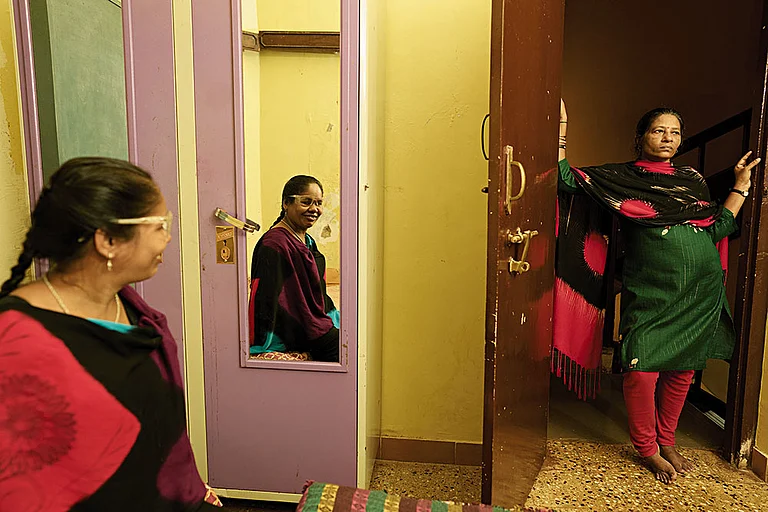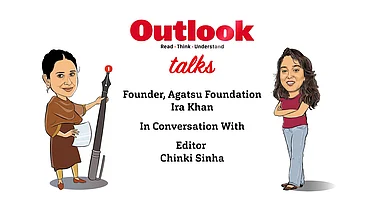
'Girl therapy' and 'girl dinners', once seen as quirky, relatable coping mechanisms, have been commodified into aesthetic quick fixes.
Psychologists caution against trivialising women’s mental health or romanticising disordered eating.
The risk of turning emotional distress into performative, consumable content is real.

'Girl therapy' and 'girl dinners', once seen as quirky, relatable coping mechanisms, have been commodified into aesthetic quick fixes. Psychologists caution against trivialising women’s mental health or romanticising disordered eating. Building community is fine, but the risk is of turning emotional distress into performative, consumable content.
With the evolution of internet culture, digital spaces have been saturated with tongue-in-cheek trends which often transcend their original forms. Take, for instance, wine glasses with sob-story captions, accompanied by the hashtag ‘Girl therapy’, or a bowl of ‘ice’ being eaten by a girl with the hashtag ‘Girl dinner’. A world of whimsical pastels is projected onto the billboard—quirky coping mechanisms that are aestheticised, commodified and widely shared as bite-sized content.
Do such trends democratise mental health discourse or dilute it? What happens when mental health becomes a punchline—and more importantly, who can afford the luxury of turning their mental health into a consumable narrative?
The viral trend of ‘Girl therapy’ emerged as an offshoot of a much more positive discourse over self-care, encouraging women to carve out time for themselves and engage in activities that offer relief from the demanding pace of their daily lives. ‘Girl therapy’ offered a much-needed respite and a safe space, due to which relatability became the gateway to solidarity amongst the community. Skincare routines, makeup rituals, matcha lattes, and artisanal coffees quickly became the aesthetic symbols of this movement. Similarly, ‘Girl Dinner’ was started by creator Olivia Maher. Girl Dinner features plates of incongruent foods (it is never a recipe), which is to say, social media is now championing the idea of picky bits. What started with cheese and charcuterie boards transcended into girls cutting through the air, accompanied by an empty plate. With humour at the forefront, it quickly gained views.
“Mental health becomes marketable through trends like these—it sells more, it becomes a vehicle of driving attention, views and aids in staying ‘relevant’ in today’s ever-changing media landscape,” says Gagandeep Kaur, a clinical psychologist and the founder/director of Unique Psychological Services, Delhi. “There is absolutely nothing wrong with engaging in skincare or dressing up; most of the things under the umbrella of girl therapy are self-care—they offer a quick break from life, but what’s wrong is that we try to rebrand pampering and glow-ups as therapy, which is very misleading,” she adds.
Something about the pastel-coloured, cotton-candied world of girl therapy has the digital discourse convinced that this time, quick fixes might actually work. It is undeniable that
problems might disappear under several layers of foundation or skincare or wine glasses, but if we peel back the aesthetic, the underlying message is conspicuous consumption. ‘Girl Therapy’ videos function less as emotional support or relatable entry points for dialogue but rather serve curated product introductions—which convince the online world that mental health is only acceptable as long as you turn it into a consumable narrative. An aestheticised illusion that material acquisition is a form of self-improvement.
Manuel Castells, sociologist and author of the book ‘The Rise of the Network Society’, states that digital and physical networks shape how we communicate, express identity, and share culture. Under this system, female coping mechanisms become part of the global affective content—posted, aestheticised, memefied, and commodified in real time.
These narratives of ‘girl dinner’ and ‘girl therapy’ are often stripped of depth and reduced to trends because of which women’s emotional labour, once stigmatised or private, is now hyper visible. However, this does not mean that people are more aware of it; it only means that women are paradoxically trivialised in a system where vitality matters the most.
“Therapy is not a fashion trend. Women are used as a commodity in trends like these, and this reinforces the historical narrative that has always been dismissive towards female mental health. Trends like these dehumanise them and pose them as fancy beings who are to be decorated,” says Kaur.
Counselling psychologist Pihu Suri explains that biological differences are often used to reinforce harmful societal narratives around women’s mental health. She points to trends like girl dinner, which, while intended to be relatable, often showcase unhealthy eating habits under the guise of humour. What began as a quirky way to make everyday meals more interesting has now evolved into something more concerning—sending problematic messages about food and self-care. She also adds that even though self-care is suggested in the entire process or journey towards mental health, it is not central to it, as there are many other factors circling it.
However, she points out that while these trends are mostly to be viewed in a negative light, they sometimes can become the entry point for coping. She cites meditation as the biggest example of this.
“Hot girl walks”, “that girl” routines, crying in Dior makeup—coping mechanisms turned into commodified self-care packages. Online campaigns and casual content like reels have undoubtedly raised awareness and helped to bring mental health to the forefront today, but we run the risk of romanticising mental illnesses, which in turn alienates those who are severely affected by them. There’s a fine line between destigmatising mental health struggles and glorifying them—a distinction many digital platforms often fail to recognise.
On one hand, Girl Dinner offers a form of humorous solidarity in the digital community, which recognises the comfort of choosing not to cook a full meal after a long day. On the other hand, it teeters dangerously close to normalising disordered eating patterns, especially when empty plates or ice cubes are passed off as quirky or relatable. What began as casual commentary on modern eating habits has now morphed into a celebration of restriction, which praises minimalism.
The female coping mechanism or the larger discourse around women’s mental health has always been viewed through a dismissive lens, whether it be centuries-old ‘hysteria’ or today’s viral trends of girl therapy and girl dinner. Women are portrayed through a very simplistic lens wherein they conform to societal ideals of eating less, as depicted via girl dinner or "fancy beings” whose happiness is directly proportional to fashion and beauty. This framing contributes to a troubling pattern of self-neglect and infantilisation, “where women’s mental health is branded as girls’ mental health, ultimately minimising the seriousness of the issue,” as Ms.Gagandeep states.
Girl Therapy and Girl dinner started off from a place of community solidarity or shared experiences and perhaps even emotional distress or fatigue, and it also underlies Gen Z’s instinct to cope through community, humour, and aesthetics. They hold the potential to foster connection, create safe spaces, and momentarily ease the weight of daily life. However, with these hashtags now surpassing billions of views, these supposed coping mechanisms are commodified and turned into consumable narratives for the internet, which are misleading—they are marketed as a quick fix, but instead they only leave a person feeling more empty. And the worst of all, they risk trivialising the very struggles they claim to represent.
At the periphery of the digital age, emotional distress or mental health is turned into a punchline wherein pain has become performative—an aesthetic package to be shared along through selfies and captions.
Healing cannot be hashtagged. And therapy, no matter how pretty it looks on a feed, is more than a skincare routine or an empty plate dressed up as dinner. It's time we stop confusing aesthetic coping for actual care.



























